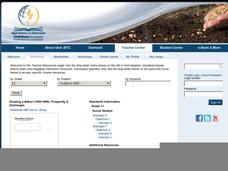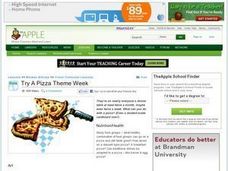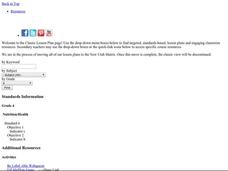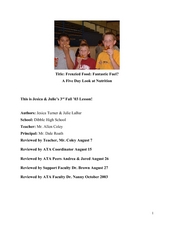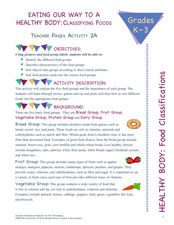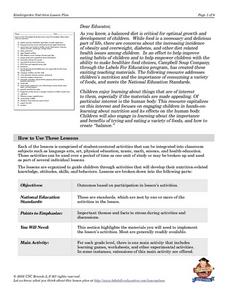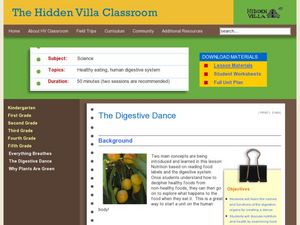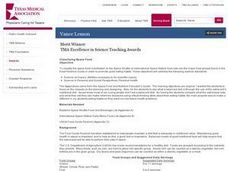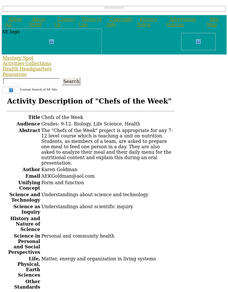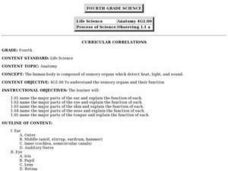Agriculture in the Classroom
Growing a Nation (1950-1969): Prosperity & Challenges: The Story of American Agriculture
A wonderful lesson on the development and impact of mechanized farming! History or agriculture classes learn the historical background of the United States' food production by creating a pamphlet with information on the cause and...
Agriculture in the Classroom
Growing a Nation: Into a New Millennium 1970-Present
If you want to focus on critical thinking skills, this well-constructed series of activities will challenge your history or agriculture class to evaluate the effectiveness of administrative decisions related to agricultural and the...
Curated OER
Evaluating Information on Food Labels
What kinds of foods include corn? Corn syrup? Start by viewing a clip of Food Inc. with your middle or high schoolers. Then, study a list of corn-derived ingredients, encouraging your class to see how many food products contain corn. A...
Curated OER
Try A Pizza Theme Week
Young scholars explore all the things they could do with a pizza. They become aware of food groups and nutritional needs, make decorated cardboard pizzas, interact with pizza slices and fractions, create stories to go along with their...
Curated OER
Little Bees, Big Potential
After reading an article on the alfalfa leafcutting bee, learners chart its characteristics alongside those of the honeybee. Then they draw the leafcutter lifecycle. The article provides fascinating reading when studying the role of...
Curated OER
What's the Shape of Your Diet?
Fourth graders discover a healthy diet. In this healthy diet lesson, 4th graders compare their typical diet with the recommendations of MyPyramid for Kids.
Curated OER
That Was Then, This Is Now
Fifth graders examine the world power of the United States. In this Social Studies lesson, 5th graders choose a world issue and identify ways the United States could help to solve the situation. Students determine the consequences and...
Curated OER
Yeasts and Molds: Food Science, Bacteria, Fungi
In this lesson students will consider the characteristics and nature of yeast and molds in order to help them understand how these microorganisms affect food production.
Curated OER
Frenzied Food: Fantastic Fuel?
Students infer the causes of obesity. In this health science lesson plan, students brainstorm ways improve to their diet. They write personalized journals with goals on how to live a healthy lifestyle.
Curated OER
Perceived Overweight and Actual Weight Risk Classification
Students calculate their BMI and compare it to a healthy weight chart. In this health lesson plan, students compare the perception of overweight with healthy weight charts. Students interpret collected data and evaluate their own...
Curated OER
Food and the Digestive System
Students investigate the digestive system. In this human biology lesson, students read an article about the digestive system and go onto a suggested website to review what they have learned. Students are asked questions as an assessment.
Curated OER
Eating Our Way to a Healthy Body: Classifying Foods
Students examine the major food groups. In this classifying foods lesson, students discover the 5 food groups as they read books and play games. Students then sort foods into the appropriate food groups
Curated OER
The Food Pyramid
Third graders investigate the concept of The Food Pyramid and its importance as a foundation for good health. They use the computer lab as a class to construct projects using the Kidpix software to make their own imitations of The Food...
Pulitzer Center
Food Insecurity
Food insecurity, whether as a result of food scarcity or a lack of nutritious food, is a growing and serious problem in the world today. After discussing the concept of food insecurity, learners listen to an NPR radio broadcast on the...
Curated OER
The ABC's of Breakfast
Students identify the food group of various culturally diverse breakfast foods and discuss the importance of eating a healthy, well-balanced breakfast every morning. They then try different foods that begin with the letter A, B and C and...
Curated OER
The Digestive Dance
Young scholars read food labels to compare healthy verses non healthy food and then use diagrams to create a poster of the digestive system. In this food lesson plan, students move the food down the digestive track along the digestive...
Curated OER
Classifying Space Food
Students write a written summary of what they have learned about the astronaut nutritional diet in comparison with their own diet habits.
Curated OER
Have You had Your *5 a Day*?
Students examine *5 a Day* Dole program to reinforce facts learned about nutrition.
Curated OER
What's on Your Plate?
Students analyze the calorie content of food. In this health science lesson plan, students discuss how excess calories affect our body. They write a healthy meal plan for their family.
Curated OER
Grocery Store Problem Solving
Fourth graders explore healthy eating habits by viewing instructional videos in class. In this food pyramid lesson, 4th graders identify the different classifications within the food pyramid and identify how they can improve overall...
Curated OER
Chefs of the Week
Students, as members of a team, are asked to prepare one meal to feed one person in a day. They analyze their meal and their daily menu for the nutritional content and explain this during an oral presentation.
Curated OER
Eggs, Baked Eggs Lab, Day 2
Students examine the structure, sizes and nutritional value of eggs. After completing a word search, they participate in a lab in which they make baked eggs with bacon. To end the lesson, they test their final product and complete a lab...
Curated OER
Eggs, Egg Test, Day 6
High schoolers review their knowledge of eggs, their structure and nutritional value. After the test, they complete an egg lab and turn in their samples to the teacher. To end the instructional activity, they determine their egg score...
Curated OER
Anatomy
Fifth graders identify and describe the functions of the major body systems. They discover how to maintain a healthy lifestyle with proper nutrition and exercise. They answer comprehension questions to end the activity.


